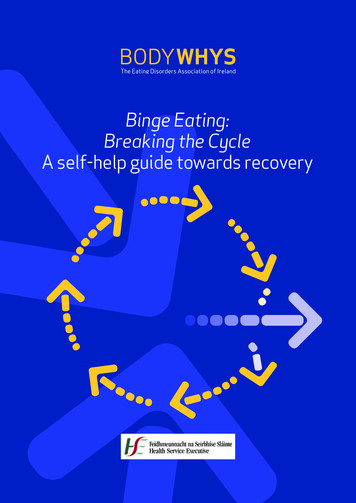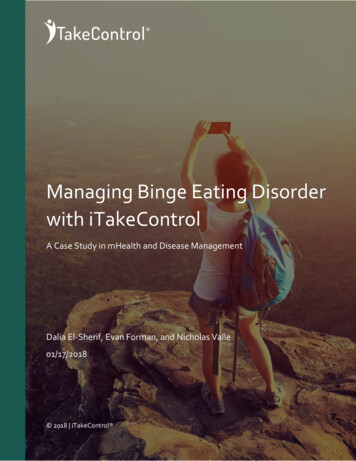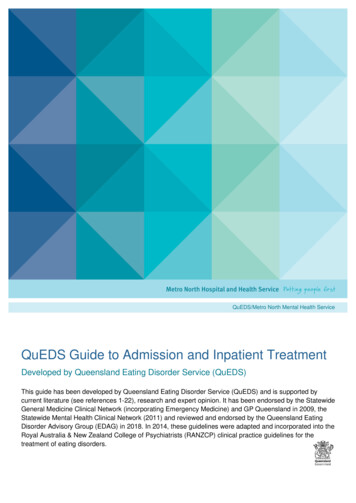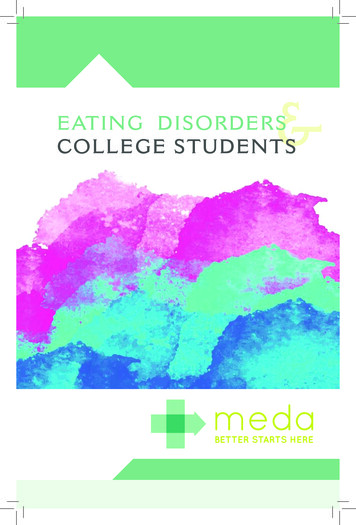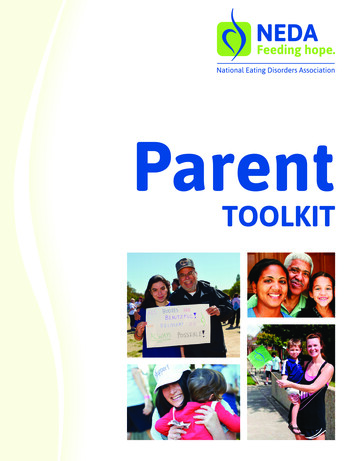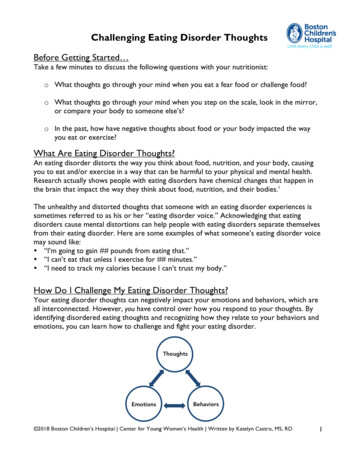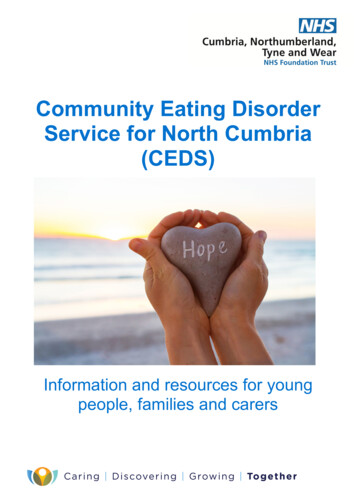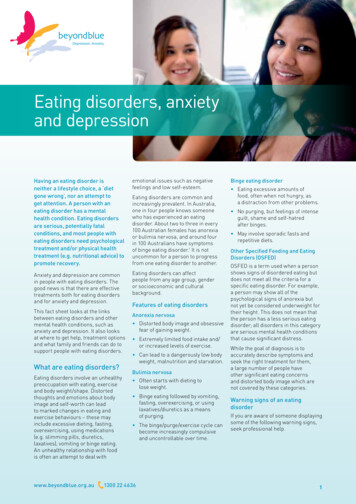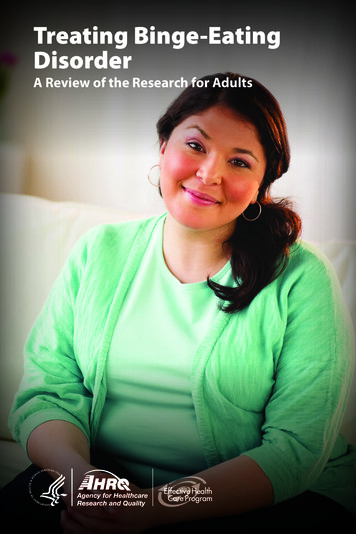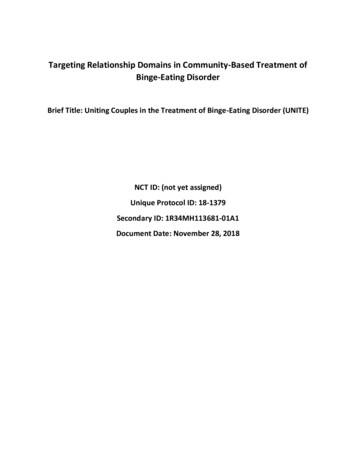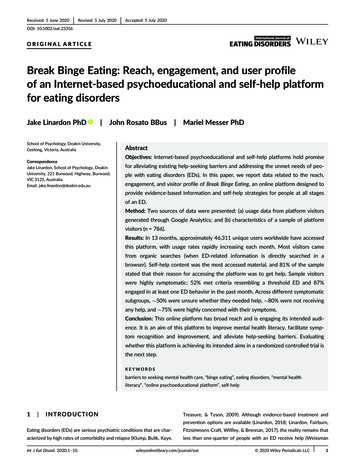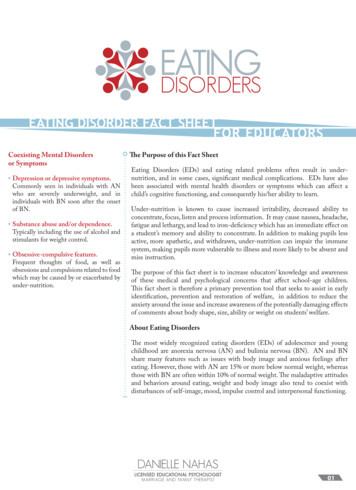
Transcription
EATING DISORDER FACT SHEETFOR EDUCATORSCoexisting Mental Disordersor Symptoms Depression or depressive symptoms.Commonly seen in individuals with ANwho are severely underweight, and inindividuals with BN soon after the onsetof BN. Substance abuse and/or dependence.Typically including the use of alcohol andstimulants for weight control. Obsessive-compulsive features.Frequent thoughts of food, as well asobsessions and compulsions related to foodwhich may be caused by or exacerbated byunder-nutrition.The Purpose of this Fact SheetEating Disorders (EDs) and eating related problems often result in undernutrition, and in some cases, significant medical complications. EDs have alsobeen associated with mental health disorders or symptoms which can affect achild’s cognitive functioning, and consequently his/her ability to learn.Under-nutrition is known to cause increased irritability, decreased ability toconcentrate, focus, listen and process information. It may cause nausea, headache,fatigue and lethargy, and lead to iron-deficiency which has an immediate effect ona student’s memory and ability to concentrate. In addition to making pupils lessactive, more apathetic, and withdrawn, under-nutrition can impair the immunesystem, making pupils more vulnerable to illness and more likely to be absent andmiss instruction.The purpose of this fact sheet is to increase educators’ knowledge and awarenessof these medical and psychological concerns that affect school-age children.This fact sheet is therefore a primary prevention tool that seeks to assist in earlyidentification, prevention and restoration of welfare, in addition to reduce theanxiety around the issue and increase awareness of the potentially damaging effectsof comments about body shape, size, ability or weight on students’ welfare.About Eating DisordersThe most widely recognized eating disorders (EDs) of adolescence and youngchildhood are anorexia nervosa (AN) and bulimia nervosa (BN). AN and BNshare many features such as issues with body image and anxious feelings aftereating. However, those with AN are 15% or more below normal weight, whereasthose with BN are often within 10% of normal weight. The maladaptive attitudesand behaviors around eating, weight and body image also tend to coexist withdisturbances of self-image, mood, impulse control and interpersonal functioning.01
EATING DISORDER FACT SHEETFORTHE CLASSFOREDUCATORSTerminologyAnorexia Nervosa Binge behavior/binge-eating:The consumption of large amounts of foodthat is considered much larger than theamount most individuals would eat undersimilar situations within a given period oftime. The hallmark of binge-eating is thefeeling of loss of control.AN is a form of self-starvation and it is characterized by low body weight (lessthan 85 percent of normal weight for height and age). These symptoms are oftenassociated with a fear of the consequences of eating such as weight gain or obesity,and they appear to be driven by disturbances in the way body weight and shapeare perceived by the individual. There are two types of AN: binge-eating/purgingtype and restrictive type. Binge-eating/purging type describes those who regularlyengage in binge eating or purging behavior. Restrictive type describes individualswho don’t engage in binge-eating or purging, but restrict their food intake. Purge behavior/purging:To empty the contents of the stomachor bowels. Methods of purging includevomiting, enemas, laxatives and excessiveexercise. Restrictive type:A type of AN in which the individualrestricts food consumption to preventweight gain. Inappropriate compensatory behaviors/methods:Self-induced vomiting, fasting and misuseof diuretics, laxatives, enemas or diet pillsto prevent weight gain. Excessive exerciseis also an inappropriate compensatorybehavior/method that is often overlookedby parents and educators.PrevalenceThe lifetime prevalence of AN is less than 1%and the lifetime prevalence of BN is 1-3%,however, the prevalence of partial syndromeis at least twice that of full syndrome ED.AN and BN occur more frequently inindustrialized nations and the rate ofoccurrence in males is one-tenth of that infemales.In general, eating disturbances are equallycommon among Hispanic and Caucasianfemales, more frequent among NativeAmerican females, and less frequent amongAfrican and Asian American females.Risk factors for EDs are greater amongminority females who are younger, heavier,better educated.Bulimia NervosaBN is characterized by binge-eating and inappropriate compensatory methods.There are two types of BN: purging type and non-purging type. Purging typedescribes those who regularly engage in purging behaviors such as self-inducedvomiting, use of laxatives, enemas and/or diuretics. Non-purging type describesthose who use other inappropriate compensatory behaviors such as fasting and/orexcessive exercise. Excessive exercise as a means of purging is often overlooked byparents and teachers.The Spectrum of Eating DisordersThe diagnosis of Eating Disorders Not Otherwise Specified (ED NOS) is madewhen significant eating problems exist but specific criteria for AN or BN are notmet. The prevalence of partial syndrome EDs is at least twice that of full syndromeEDs, placing AN and BN at the extreme end of a continuum that begins withbody dissatisfaction, over concerns around weight and shape, calorie restriction anddieting.The good news is that interventions introduced at any place along the continuummay result in decreased incidence or prevalence of EDs. This seems to be especiallytrue for interventions applied to prevent or decrease the earliest symptoms in the EDcontinuum such as body dissatisfaction, weight concerns and dieting. An example ofa great prevention program that can be implemented by teachers is Full Of Ourselves(FOO). FOO is a health and wellness education program that addresses criticalissues of body preoccupation and reduces risk for disordered eating.Obesity and the Continuum of Eating DisordersThe field of EDs and eating problems is filled with controversies around causes,treatment and prevention, as well as around the relationship between obesity andeating disorders. Of relevance is that though some obese individuals may meetdiagnostic criteria for BN, most do not report the presence of inappropriatecompensatory behaviors. In essence, though binge eating may be common amongsome obese individuals, the etiology of binge eating and dieting behavior among thispopulation is largely unknown. Despite this, it is important to consider that obesityis caused by many factors including genetic, environmental and biological factors.Obesity also places the individual at risk for being teased or rejected which can leadto body dissatisfaction and trigger pressure to be thin and/or dieting.Selective and Picky EatingChoosiness is a feature of the typical “picky eating”, and it is common during thetoddler years; however, growth, development and overall caloric intake tend to beadequate for these children. Selective eating is a severe pattern of “picky eating” andit occurs when individuals narrow their food selection to the extent that they areconsuming insufficient amounts of key vitamins and minerals. At this time, morestudies are needed to investigate the effects of childhood picky eating behaviors onthe development of EDs later in life.Danielle Nahas, Psy.D. daniellenahas@yahoo.com02
EATING DISORDER FACT SHEETFORTHE CLASSFOREDUCATORSRisk factors Biological Risk Factors Dieting - one of the most seriousbehaviors underlying the developmentof ED symptoms. Food restriction hasbeen linked to starvation behaviors, andboth dieting and weight loss provideyoung individuals a sense of controlat an age when control and autonomyare important. Also, dieting has beenassociated with binge eating, anddeprivation of food has been thought tocontribute to eating at a psychologicaland physiological level. Obesity - body mass plays a rolein promoting risk factors for eatingpathology. In addition to be a riskfactor for perceived pressure to be thin,body dissatisfaction and dieting, itplaces the individual at risk for beingteased. In today’s society weight loss isoften celebrated and thereby reinforced.In addition to experience a sense ofachievement following desired weightloss, compliments associated withweight loss may positively reinforce anindividual’s desire to lose further weight,regardless of the appropriateness of sucha decision. Puberty - puberty brings about manybody changes such as breast developmentand weight gain which can be difficult forthose who mature earlier than their peers.These changes can increase an individual’sbody awareness, create insecurities, bodydissatisfaction and increase dieting andunhealthy eating behaviors. Also, highlysensitive girls may experience puberty asa loss of control over their bodies. Genetics - first degree relatives shareboth genes and environments, makinggenetic and environmental causes forEDs difficult to differentiate. In spite ofthis, genetic vulnerability for EDs maybe transmitted in families. Socio-cultural Risk Factors Thin-ideal - the thin-ideal relates tothe socio-cultural tendency for thinnessand the model skeletal look seen inmagazines and television. Individuals,especially adolescents, may define whattheir bodies should look like based onwhat is seen in the media. Some idealize Maternal body dissatisfaction andthe thin bodies seen in the media, andparental overweight status may encourageview them as something to be achieved.children to become concerned with theirThese individuals then compare theirown body weight, in addition to fosterown bodies to the “idealized” body, andsecretive eating patterns that may serve toconclude that they are coming up shortshield from peer ridicule about weight.in comparison. This, in the very least, Maternal dieting and pursuit forcan result in body dissatisfaction, lowerthe thin-ideal promote children’sself-esteem and self-concept and triggerinternalization of these goals, and canan individual to strive to reach the “ideal”lead to reduced eating in the children, andby whatever means necessary. The moreconsequently increased risk of overeating,these individuals compare their own body,a likely contributor to obesitythe more they strive to be thin, disliketheir bodies and engage in unhealthy Psychological Risk Factorsbehaviors.External pressures to look thin and Peer pressure - Peer pressure is ofmaintain control of one’s body weightparticular importance when consideringand appearance may interact withthat in adolescence, friendships becomecertain psychological characteristics tomore influential in the developmentincrease the risk for eating disturbances.of attitudes and beliefs about the selfHowever, this complex, interactiveand the world. Specific peer pressuresprocess involving many levels ofrelated to eating problems include thebiological, familial, personality andimportance peers play on weight andenvironmental factors make specificeating, along with an individual’s desirecausal connections difficult to identify.to be popular.The affect-regulation model suggests Desire to be popular - The desirethat individuals may binge eat in anto be popular is largely due to theeffort to obtain comfort and distractionmedia portrayal of the thin-ideal bodyfrom negative emotions. In this case,which has been linked to general bodyindividuals may use vomiting to reducedissatisfaction, image misconceptionsanxiety about possible weight gain orand increased prevalence of EDs.because they believe that purging servesas an emotional release. Familial Risk FactorsOvert and/or subtle parental attitudes canstrongly influence a child’s perception ofweight and food, in addition to influenceeating attitudes and behaviors throughoutvarious stages of development. Children of overweight mothersdevelop a concern about becomingoverweight which may manifest asinhibiting eating behaviors. Parental modeling in the form ofmaternal or parental complaints abouttheir own weight is associated withweight loss attempts and body esteem,especially in girls.Perfectionism is the most widelyrecognized personality trait associatedwith eating problems since it mayencourage a relentless pursuit of thethin-ideal. In the educational setting,perfectionism may be manifested as“perfect” handwriting, grades andappearance.Body distortion or inaccurate bodyperception is also an important factor inbody image. Maternal bulimic behaviors presentan opportunity for children to acquirethese behaviors through modeling andencourage the perception that eating issomething to be done covertly.Danielle Nahas, Psy.D. daniellenahas@yahoo.com03
EATING DISORDER FACT SHEETFORTHE CLASSFOREDUCATORSWarning SignsIn regards to warning signs, it is important to keep in mind that 1. Some exhibit many early signs while others only a few; 2.EDs are secretive in nature, therefore the first identification may not indicate the disorder is in its initial phase. 3. Proof is notnecessary - having a concern that something may be going on with a student is enough to discuss your concerns with the schoolcounselor and/or to initiate a conversation with the student and/or a family member.Early detection may be improved by increasing awareness of the following indicators: Social Decreased interest in hobbies andactivities previously enjoyed, in additionto withdrawal from social situations,especially those involving food. Over exercising, exercising at inappropriatetimes, fluctuating exercise patterns Increased interest in watching cookingshowsdiarrhea, cramps Indigestion, heartburn Sore throat due to frequent vomiting Easy Bruising Increased interest in collecting foodcoupons and/or recipes Dehydrationvomiting Relationship problems Trips to the bathroom after meals Hypoglycemia (low glucose levels)which can cause confusion, illogicalthinking, shakiness, irritability and coma. Self-critical, overly sensitive tocriticism Vegetarianism Bowel problems such as constipation, Behavioral Dieting or overeating Decreased interest in preparing foodor increased interest in preparing but noteating Obsessive rituals such as only eatingout of a certain plate or eating certainfoods on certain days Underachievement or overachievementat work or at school Change in clothing style or tendency towear baggy clothes. Over exercising, exercising atinappropriate times, fluctuating exercisepatterns Frequent excuses not to eat Eat very slowly or too fast, rearrangefood on the plate, hoard food Sore on knuckles Physical Loss of menstruation in females Weight loss, rapid fluctuations inweight Emotional/Psychological Preoccupation with body appearance Faintness, dizziness or fatigueand body weight Increased sensitivity to cold Mental list of “good and bad foods” Decreased metabolic rate which leads Anxiety around meal times and feelingsto slow heart rate, low blood pressure,ofbeing out of control with foodreduced body temperature and bluishcolored extremities Feelings of anxiety, guilt, depression,moodiness,irritability Changes in hair, skin and nails whichmay become dry and brittle Obsessive behaviors, history of suicidalthoughtsand/or behaviors Fluid retention (puffiness) Decreased concentration, memory and "Chipmunk cheeks" occur whenthinkingabilitysalivary glands expand due to frequent Lack of assertiveness Alcohol and drug use PreventionEDs and eating-related problems are significant medical and psychological concerns that typically manifest during adolescence.Prevention is aimed at reducing the incidence of EDs by targeting risk and protective factors (variables that diminish the negativeeffects of risk factors). Risk and protective factors exist within the individual, the school environment, peer relationships and thewider community, thus making a coordinated school approach an effective means to address multiple risk and protective factors.To date, many prevention programs focus at reducing “malleable” risk factors such as thin-ideal internalization, body dissatisfactionand negative affect while also decreasing factors that amplify the effects of other risk factors such as pressure to be thin andperfectionism. By increasing protective factors, such as social support and self-esteem, prevention programs may also bring aboutoverall improvement in mental health, in addition to successful prevention of EDs and eating-related problems. TreatmentThere are many different treatments for EDs and eating-related problems. Given the variety of symptoms that individuals mayexperience, different health practitioners may need to be involved in the treatment. A multi-disciplinary approach is most oftenutilized, and the treatment team may include general physicians, pediatricians, psychiatrists, dietitians/nutritionists, psychologists/therapists, nurses, social workers and occupational therapists. In addition, some individuals may require nutritional counseling tohelp them identify their fears around food and promote both healthy eating habits and the understanding of the consequences ofnot eating well. Psychological treatment may include individual, group and family therapy with an experienced therapist.Danielle Nahas, Psy.D. daniellenahas@yahoo.com04
EATING DISORDER FACT SHEETFORTHE CLASSFOREDUCATORSEating Disorders and the SchoolsEDs typically manifest during adolescence and many children begindieting in the elementary years. In addition to adopt a preventionoriented atmosphere that prohibits in-school advertising, teasing,harassment and gender-biased discussions, schools must encouragehealthy nutritional behaviors and provide opportunity for positivephysical activity. Schools may also wish to adopt prevention programsthat can be implemented by teachers such as the Full of Ourselves(FOO).EducatorsThe understanding that EDs usually begin during school-age highlightsthe fact that educators are exposed to students who may be at-risk.Because teachers and other educators are in close contact with childrenand adolescents, they are prime candidates for the identification ofchanges in the welfare of students.What else can educators do?1.Create a school environment where all students feel safe fromharassment. Establish zero tolerance on teasing, taunting and negativetalk about students’ bodies2.Teach media literacy skills to ensure that students have the skills tobe critical consumers and to understand that media images are oftenmodified or enhanced. Teach students that images, commercials andtelevision shows have messages, created by individuals or groups withspecific agendas and/or points of view3.Focus physical education on skills building and establishing healthyhabits, rather than focusing on weight management4.Ensure that school lunches have healthy options and that vendingmachines have healthy snacks5.Include prevention information such as healthy eating and lifestylestips in the curriculum. Teach students a non-dieting philosophy,whole nutrition and eating all colors of foods6.Don’t weigh students in front of each other. Group weight-ins maymake students consider weight an important indicator of self-worth7.Avoid placing scales in public places where students with body orweight concerns can be overly focused on weighing themselves8.Don’t measure students’ body fat with calipers. Some students mayobsess over the results of the fat caliper testing and view them as ameasure of their self-worth9.Ensure that participation in school or extracurricular activities isnot limited by physical size or shape10.Provide general information about EDs but do not show moviesof individuals with EDs - movies may present “new ways to loseweight” and inadvertently teach an individual how to develop an ED11.Don’t show videos on animal cruelty. It traumatizes children tobecome vegetarian which may lead to food avoidance/phobia andpossibly an EDthe children to diet which is a risk factor and triggerfor EDs13.Confront students who talk negatively abouttheir bodies or about restricting their food intake tolose weight. Respond immediately and stress thattheir bodies need fuel several times daily to be able tothink, grow, and be healthy. Emphasize that internal- not external - beauty is important14.Incorporate ED prevention groups that arebased on wellness and limit detailed descriptions ofeating-disordered behaviors and consequences. Thismay be done by collaborating with a local collegeor university or following an established curriculumsuch as Full of Ourselves (FOO).15.Encourage the establishment of appropriateprocedures and the identification of resources toassist students in need of help. Share your concernsabout at-risk students with the school counselor andthe school nurse for a possible referral to a qualifiedprofessional16.Closely monitor elementary school studentsdisplaying obsessive-compulsive behaviors as theyare likely to develop an ED as they go throughpuberty.Educational SupportOnce ED symptoms reach clinical levels, students willrequire comprehensive and multifaceted care that isbeyond what is available in the educational setting.Ideally, schools should establish a school supporttransition team including educators, mental healthprofessionals, medical and nutritional practitioners,and/or identify specific liaisons to communicate withtreatment teams and coordinate services and supportswithin the educational environment.In some cases, Section 504 plans or special educationservices and supports may be required in orderto provide or facilitate access to the curriculum.Accommodations and supports are based on individualneeds, and they may range from accommodating formedical or therapeutic appointments during schoolhours to school-based counseling, medical monitoring,release from physical education, meal monitoring orsupport and ongoing communication with treatmentteam and family. Academic consultation or hospitaleducational services may be required when inpatienttreatment for health or psychiatric reasons is required.12.Watch your own dieting behaviors. Teacher dieting can influenceDanielle Nahas, Psy.D. daniellenahas@yahoo.com05
EATING DISORDER FACT SHEETFORTHE CLASSFOREDUCATORSREFERENCES AND RESOURCESCook-Cottone, C. & Phelps, L. (2006).Adolescent eating disorders. In G. Bear & K. M. Minke (Eds.), Children’s needsIII: Development, prevention and intervention (pp. 977-988).Keca, J. & Cook-Cottone, C. (2005).Middle school and high school programs help beat eating disorders. PrincipalLeadership, October 2005,33-39.Nahas, D. (2010).Development of a fact sheet for educators promoting awareness of eating disorders(Doctoral dissertation, Alliant International University, 2010).National Eating Disorders Association (NEDA). (2008).The National Eating Disorders Association educator ak, L., Harris, B., Levine, M.P. & Shisslak, C. M. (2001).Teachers: The forgotten influence on the successes of prevention programs. EatingDisorders, 9, 261-265.The Victorian Centre of Excellence in Eating Disorders (CEED) and theEating Disorders Foundation of Victoria (EDFV). (2004).An eating disorder resource for schools. The Victorian Centre of Eating Disordersand the Eating Disorders Foundation of Victoria. Victoria, Australia.White, J. H. (2000).The prevention of eating disorders: A review of the research on risk factors withimplications for practice. Journal of Child and Adolescent Psychiatric Nursing,13(2), 76-88.ADDITIONAL RESOURCESAcademy for Eating Disordershttp://www.aedweb.org/A 5- day lesson plan on eating disorders.Levine, M., Hill, L., Seattle, WA, EDAP, 1991BODYWISE. Eating Disorder Information For Middle School Personnel.U.S. Department of Health and Human Services. Office of Women’s dfEating Disorders Foundation of Victoriahttp://www.eatingdisorders.org.auHealthy body image: Teaching kids to eat and love their bodies.Kater, K., Seattle, WA, EDAP, 1998.Maine, M. (2000).Body wars: Making peace with women’s bodies. Carlsbad, CA: Gurze Books.Steiner-Adair, C. & Sjostrom, L. (2006).Full of ourselves. New York: Teachers College Press.The Nemours Foundationhttp://kidshealth.orgThe Something Fishy Website on Eating Disordershttp://www.something-fishy.orgThe Victoria Centre of Excellence in Eating Disordershttp://www.ceed.org.auACKNOWLEDGEMENTSI would like to acknowledge and thank the expert reviewers Divya Kakaiya,PhD; Jennifer Shapiro, PhD; and Laura McGrady, PsyD; whose insight andexpertise were essential in the development of this fact sheet. I would also liketo acknowledge and give special thanks to Caio Nahas de Laurentiz, GraphicDesigner (www.caionahas.com) whose talent and expertise were fundamental inthe development of this fact sheet.Danielle Nahas, Psy.D. daniellenahas@yahoo.com06
EATING DISORDER FACT SHEET FOR EDUCATORS Th e Purpose of this Fact Sheet Eating Disorders (EDs) and eating related problems often result in under- . FOO is a health and wellness education program that addresses critical issues of body preoccupation and reduces risk for disordered eating.
